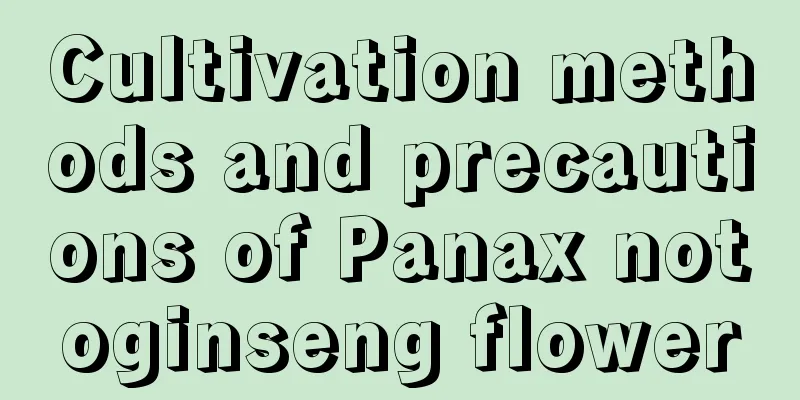Cultivation methods and precautions of Panax notoginseng flower

1. Maintenance methods1. Soil: It grows best in fertile, breathable and well-drained sandy soil, and the soil should be kept moist. You can use sawdust or leaf mold to prepare the soil, but make sure it is kept clean. 2. Light: In summer, you need to block the sunlight to avoid being exposed to the scorching sun. It can accept oblique, scattered and slow light, but cannot accept strong light. 3. Temperature: It will grow better in an environment of 18-25℃, and should not exceed 35℃ in summer. Try to keep the temperature above 5℃ in winter to ensure it survives the winter smoothly. 4. Water: In spring and summer, you need to water it two or three times a month. During the wintering period, the watering frequency must be reduced or even stopped altogether. 2. Breeding techniques1. Sowing: Sowing can be done in October and November every year. Place the seeds evenly in the soil and water them. Make sure the temperature remains around 20°C to ensure the survival of the seeds. 2. Summer: The temperature in summer should be below 35℃, at which temperature breeding can be carried out. Please note that in summer you need to shade yourself from the sun and replenish water in time. 3. Problem diagnosis and treatment1. Damping-off disease: Brown and dry growth occurs when the seedlings are young. Once discovered, timely prevention and treatment is required. Bordeaux mixture or fungicides such as dichlorodiphenyltrichloroethane can be used alternately for spraying, and the diseased plants should be pulled out in time and burned quickly. 2. Black spot disease: Brown spots will appear on its stems, leaves, flowers and fruits. The diseased leaves or branches need to be cut off as soon as possible, and the timely use of polysaccharides can effectively kill the black spot disease. IV. Other issues1. Is it toxic? The information shows that it is non-toxic, so there is no need to worry about toxicity during the breeding process. 2. Can it be grown at home: It can be used as a potted plant at home. It is recommended to grow it in a place with good indoor lighting conditions and ventilate it frequently. It can be placed on an outdoor terrace or in the courtyard at home. It is very convenient and easy to take care of and can be enjoyed. |
<<: Basil seed cultivation methods and precautions
>>: Stevia cultivation methods and precautions
Recommend
How to propagate jade tree by cuttings
1. Leaf cuttings The leaf cutting method is very ...
Breeding techniques of Fraxinus chinensis
1. Planting 1. Seed collection: The seeds will ma...
How to grow plant curtains? Do this and it’ll be done in a month!
Bead curtains Buddha beads, also known as pearl s...
Sweet Osmanthus Growth Environmental Conditions and Characteristics
Sweet Osmanthus Growth Environmental Conditions a...
How to grow old succulent plants
1. What is an old pile? When we grow succulents, ...
When is the best time to sow adzuki beans?
Adzuki bean sowing time Adzuki beans belong to th...
The efficacy and function of Fritillaria
1. Medicinal value It is recorded in many books o...
How to change the pot and soil of spider plant?
Chlorophytum is a very common foliage plant with ...
What should I do if the leaves of azalea turn yellow and dry like rust?
Rhododendrons are loved for their beautiful flowe...
Does snapdragon prefer shade or sun?
Does snapdragon prefer shade or sun? Snapdragons ...
Rice growing environment and local conditions
Rice growing environment and conditions Rice gene...
Cultivation methods and precautions of Carnation
Carnation is very easy to grow. It can survive fr...
How to propagate Buddha's hand by cuttings
Cutting propagation of bergamot Cutting preparati...
How often should I water the fortune tree?
If you want to grow a money tree well, watering i...
How to cultivate sea dianthus
1. Maintenance methods 1. Temperature: It likes a...









